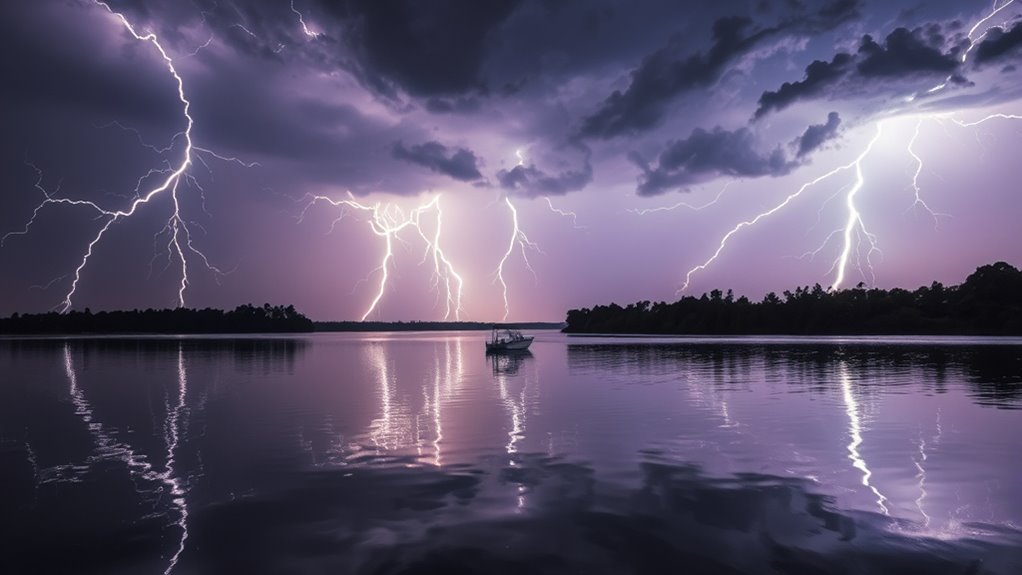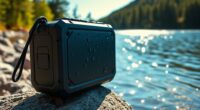When lightning strikes on a lake, your safety depends on quick action and awareness. Always check the weather forecast before heading out and stay alert for darkening clouds, fast-moving storms, or sudden drops in temperature. If lightning appears or thunder sounds, get off the water immediately and seek shelter onshore or inside a sturdy boat cabin. Avoid metal objects, water, and electronics during a storm. To learn essential storm safety protocols to keep you safe, continue exploring this crucial information.
Key Takeaways
- Seek shelter immediately in a sturdy building or boat cabin at the first sign of lightning or a storm.
- Avoid metal objects, water, and open areas; stay low and away from boat metal parts.
- Do not attempt to outrun a storm; head to shore or safe shelter as soon as possible.
- Use weather alerts and apps to monitor real-time storm warnings before and during lake outings.
- Remember lightning can strike miles from rainfall; stay vigilant even if the storm seems distant.

Have you ever witnessed lightning dancing across a lake’s surface? It’s a breathtaking sight, but one that can turn deadly in seconds if you’re unprepared. When you’re out on the water, understanding storm safety and staying aware of weather conditions becomes essential. Lakes are particularly dangerous during thunderstorms because lightning can strike the water, which conducts electricity rapidly, making everyone in the vicinity vulnerable. That’s why knowing what to do—and what not to do—is vital for your safety.
The first step in protecting yourself is developing strong weather awareness. Always check the forecast before heading out, and keep an eye on the sky while you’re on the water. Darkening clouds, a sudden drop in temperature, or an increase in wind speed can all signal an approaching storm. Modern weather apps and NOAA alerts can give you real-time updates, so stay connected. When you notice signs of an impending storm, it’s time to act quickly. Don’t assume that a storm will pass or that you can outrun it; storms can intensify rapidly, especially over open water.
Once you see the first flashes of lightning or hear distant thunder, it’s time to prioritize storm safety. The key rule is to get off the lake immediately. Staying on the water during a thunderstorm considerably increases your risk of lightning strikes. If you’re in a boat, head to the nearest shoreline or dock if possible, or seek shelter in a sturdy structure. Never try to outrun a storm by heading further out; it’s a dangerous gamble that often ends badly. Remember, lightning can strike several miles away from the rainfall, so even if the storm seems distant, it’s better to err on the side of caution.
At the first sign of lightning, get off the water immediately and seek shelter.
If you’re caught in a storm with no immediate shelter, stay low, keep away from metal objects, and avoid touching the boat’s metal parts or water. Keep your hands away from the sides of the boat and avoid open areas. If you’re in a larger boat with a cabin, get inside quickly and stay there until the storm passes. Also, avoid using electronic devices connected to metal or water, as they can carry a charge if lightning strikes nearby. Being aware of storm warning signals can help you react more effectively and avoid dangerous situations.
In essence, the best way to enjoy lakeside activities during storm season is to be proactive about weather awareness and to understand the critical storm safety protocols. Being prepared and staying alert can save your life, turning what could be a tragic event into a safe retreat. Never underestimate the power of weather changes—respect the storm, respect the lake, and always prioritize your safety.
Frequently Asked Questions
Can Lightning Strike a Boat Far From the Shoreline?
Yes, lightning can strike a boat far from the shoreline. Lightning strike risks increase when you’re on the water, even if you’re miles from land. You should prioritize boat safety by avoiding open water during thunderstorms, seeking shelter, and staying low. Remember, lightning can travel through water and conductive materials, so always take precautions. Staying informed and prepared helps prevent accidents caused by lightning strikes while boating.
What Safety Gear Is Best During a Lightning Storm on the Water?
Think you’re invincible on the water? Think again. During a lightning storm, your best safety gear includes a personal flotation device to stay afloat and lightning detection devices to warn you early. Forget about stylish sunglasses or flashy hats—these won’t save your life. Instead, prioritize gear that keeps you grounded and aware. Stay alert, stay safe, and remember: no boat is a lightning-proof fortress, so act fast.
How Do I Identify the Start of a Lightning Storm on the Lake?
You can identify the start of a lightning storm on the lake by watching for changing cloud formations, like darkening skies and towering cumulonimbus clouds. Stay alert through weather monitoring tools, such as a weather radio or app, which can provide early warnings. If you notice distant thunder or a sudden drop in temperature, it’s a sign that a lightning storm may be approaching, and you should seek shelter immediately.
Are There Specific Lakes With Higher Lightning Risks?
Imagine certain lakes as magnets for storm risk, drawing lightning like a lightning bolt to metal. Some lakes, especially those in open areas or with little surrounding shelter, pose higher lake lightning dangers. You should be extra cautious around large, flat water bodies such as the Great Lakes or shallow lakes prone to rapid storm development. Recognizing these riskier lakes helps you stay alert and safe when storms threaten.
What Should I Do if Someone Is Struck by Lightning on the Boat?
If someone is struck by lightning on your boat, stay calm and call emergency response immediately. Check for lightning injuries, but avoid moving them unless necessary to prevent further harm. Administer first aid if you’re trained, focusing on breathing and bleeding. Keep them warm and comfortable until professional help arrives. Remember, quick action can save lives, so stay alert and follow emergency protocols for lightning injuries on the water.
Conclusion
Now that you know the safety protocols, are you prepared to act quickly if lightning strikes while you’re on the lake? Remember, lightning can be unpredictable and deadly. Staying informed and following these simple steps could save your life. So, next time you’re out on the water, ask yourself: are you ready to prioritize safety over adventure? Don’t wait until it’s too late—make safety your top priority and enjoy the lake responsibly.










